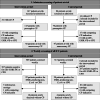An interventional quasi-experimental study to evaluate the impact of a rapid screening strategy in improving control of nosocomial extended-spectrum beta-lactamase-producing Enterobacterales and carbapenemase-producing organisms in critically ill patients
- PMID: 35672757
- PMCID: PMC9172611
- DOI: 10.1186/s13054-022-04027-8
An interventional quasi-experimental study to evaluate the impact of a rapid screening strategy in improving control of nosocomial extended-spectrum beta-lactamase-producing Enterobacterales and carbapenemase-producing organisms in critically ill patients
Abstract
Introduction: Rapid molecular tests could accelerate the control of extended-spectrum beta-lactamase-producing Enterobacterales (ESBL-PE) and carbapenemase-producing organisms (CPO) in intensive care units (ICUs).
Objective and methods: This interventional 12-month cohort study compared a loop-mediated isothermal amplification (LAMP) assay performed directly on rectal swabs with culturing methods (control period, 6 months), during routine ICU screening. Contact precautions (CP) were implemented for CPO or non-E. coli ESBL-producing Enterobacterales (nEcESBL-PE) carriers. Using survival analysis, we compared the time intervals from admission to discontinuation of unnecessary preemptive CP among patients at-risk and the time intervals from screening to implementation of CP among newly identified carriers. We also compared diagnostic performances, and nEcESBL-PE/CPO acquisition rates. This study is registered, ISRCTN 23588440.
Results: We included 1043 patients. During the intervention and control phases, 92/147 (62.6%) and 47/86 (54.7%) of patients at-risk screened at admission were candidates for early discontinuation of preemptive CP. The LAMP assay had a positive predictive value (PPV) of 44.0% and a negative predictive value (NPV) of 99.9% for CPO, and 55.6% PPV and 98.2% NPV for nEcESBL-PE. Due to result notification and interpretation challenges, the median time from admission to discontinuation of preemptive CP increased during the interventional period from 80.5 (95% CI 71.5-132.1) to 88.3 (95% CI 57.7-103.7) hours (p = 0.47). Due to the poor PPV, we had to stop using the LAMP assay to implement CP. No difference was observed regarding the incidence of nEcESBL-PE and CPO acquisition.
Conclusion: A rapid screening strategy with LAMP assays performed directly on rectal swabs had no benefit for infection control in a low-endemicity setting.
Keywords: Clinical study; Contact precautions; ICU; Infection control; Molecular test; Multiresistant Gram-negative bacteria; Screening; Surveillance.
© 2022. The Author(s).
Conflict of interest statement
None declared
Figures
Similar articles
-
Evaluation of the performance of rapid tests for screening carriers of acquired ESBL-producing Enterobacterales and their impact on turnaround time.J Hosp Infect. 2021 Feb;108:19-24. doi: 10.1016/j.jhin.2020.10.013. Epub 2020 Oct 24. J Hosp Infect. 2021. PMID: 33122041
-
Cessation of screening for intestinal carriage of extended-spectrum β-lactamase-producing Enterobacteriaceae in a low-endemicity intensive care unit with universal contact precautions.Clin Microbiol Infect. 2018 Apr;24(4):429.e7-429.e12. doi: 10.1016/j.cmi.2017.08.005. Epub 2017 Sep 26. Clin Microbiol Infect. 2018. PMID: 28962997
-
Impact of colonization pressure on acquisition of extended-spectrum β-lactamase-producing Enterobacterales and meticillin-resistant Staphylococcus aureus in two intensive care units: a 19-year retrospective surveillance.J Hosp Infect. 2020 May;105(1):10-16. doi: 10.1016/j.jhin.2020.02.012. Epub 2020 Feb 22. J Hosp Infect. 2020. PMID: 32092367
-
Is systematic fecal carriage screening of extended-spectrum beta-lactamase-producing Enterobacteriaceae still useful in intensive care unit: a systematic review.Crit Care. 2019 May 14;23(1):170. doi: 10.1186/s13054-019-2460-3. Crit Care. 2019. PMID: 31088542 Free PMC article.
-
Screening for Intestinal Carriage of Extended-spectrum Beta-lactamase-producing Enterobacteriaceae in Critically Ill Patients: Expected Benefits and Evidence-based Controversies.Clin Infect Dis. 2019 May 30;68(12):2125-2130. doi: 10.1093/cid/ciy864. Clin Infect Dis. 2019. PMID: 30312366 Review.
References
-
- Stewardson A, Fankhauser C, De Angelis G, et al. Burden of bloodstream infection caused by extended-spectrum β-lactamase-producing enterobacteriaceae determined using multistate modeling at a Swiss University Hospital and a nationwide predictive model. Infect Control Hosp Epidemiol. 2013;34(2):133–143. doi: 10.1086/669086. - DOI - PubMed
-
- Stewardson AJ, Marimuthu K, Sengupta S, et al. Effect of carbapenem resistance on outcomes of bloodstream infection caused by Enterobacteriaceae in low-income and middle-income countries (PANORAMA): a multinational prospective cohort study. Lancet Infect Dis. 2019;19(6):601–610. doi: 10.1016/S1473-3099(18)30792-8. - DOI - PubMed
-
- Cassini A, Högberg LD, Plachouras D, et al. Attributable deaths and disability-adjusted life-years caused by infections with antibiotic-resistant bacteria in the EU and the European Economic Area in 2015: a population-level modelling analysis. Lancet Infect Dis. 2019;19(1):56–66. doi: 10.1016/S1473-3099(18)30605-4. - DOI - PMC - PubMed
-
- Tomczyk S, Zanichelli V, Grayson ML, et al. Control of carbapenem-resistant Enterobacteriaceae, Acinetobacter baumannii, and Pseudomonas aeruginosa in healthcare facilities: a systematic review and reanalysis of quasi-experimental studies. Clin Infect Dis. 2019;68(5):873–884. doi: 10.1093/cid/ciy752. - DOI - PMC - PubMed
MeSH terms
Substances
Grants and funding
LinkOut - more resources
Full Text Sources
Miscellaneous



